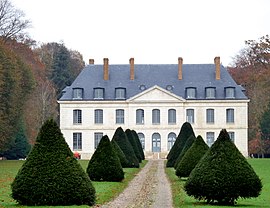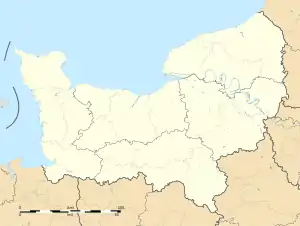Grainville-Ymauville | |
|---|---|
 The chateau of Trébons in Grainville-Ymauville | |
 Coat of arms | |
Location of Grainville-Ymauville | |
 Grainville-Ymauville  Grainville-Ymauville | |
| Coordinates: 49°39′30″N 0°25′00″E / 49.6583°N 0.4167°E | |
| Country | France |
| Region | Normandy |
| Department | Seine-Maritime |
| Arrondissement | Le Havre |
| Canton | Saint-Romain-de-Colbosc |
| Intercommunality | CC Campagne de Caux |
| Government | |
| • Mayor (2020–2026) | Serge Girard[1] |
| Area 1 | 6.29 km2 (2.43 sq mi) |
| Population | 426 |
| • Density | 68/km2 (180/sq mi) |
| Time zone | UTC+01:00 (CET) |
| • Summer (DST) | UTC+02:00 (CEST) |
| INSEE/Postal code | 76317 /76110 |
| Elevation | 93–135 m (305–443 ft) (avg. 105 m or 344 ft) |
| 1 French Land Register data, which excludes lakes, ponds, glaciers > 1 km2 (0.386 sq mi or 247 acres) and river estuaries. | |
Grainville-Ymauville (French pronunciation: [ɡʁɛ̃vil imovil]) is a commune in the Seine-Maritime department in the Normandy region in northern France.
Geography
A farming village situated in the Pays de Caux, some 19 miles (31 km) northeast of Le Havre, at the junction of the D75 and D10 roads. The SNCF railways have a station here.
Heraldry
 Arms of Grainville-Ymauville |
The arms of Grainville-Ymauville are blazoned : Azure, a chevron argent and in base 6 stalks of wheat arranged as a fan Or, and on a chief argent, 3 roses gules slipped and leaved vert.
|
Population
| Year | Pop. | ±% p.a. |
|---|---|---|
| 1968 | 255 | — |
| 1975 | 232 | −1.34% |
| 1982 | 317 | +4.56% |
| 1990 | 334 | +0.66% |
| 1999 | 392 | +1.80% |
| 2007 | 404 | +0.38% |
| 2012 | 416 | +0.59% |
| 2017 | 439 | +1.08% |
| Source: INSEE[3] | ||
Places of interest
- The church of St-Vigor-et-Notre-Dame, dating from the eighteenth century.
- The eighteenth century chateau de Grainville.
Notable people
- Nicole Fontaine, former president of the European Parliament was born here.
See also
References
- ↑ "Répertoire national des élus: les maires". data.gouv.fr, Plateforme ouverte des données publiques françaises (in French). 2 December 2020.
- ↑ "Populations légales 2021". The National Institute of Statistics and Economic Studies. 28 December 2023.
- ↑ Population en historique depuis 1968, INSEE
Wikimedia Commons has media related to Grainville-Ymauville.
This article is issued from Wikipedia. The text is licensed under Creative Commons - Attribution - Sharealike. Additional terms may apply for the media files.